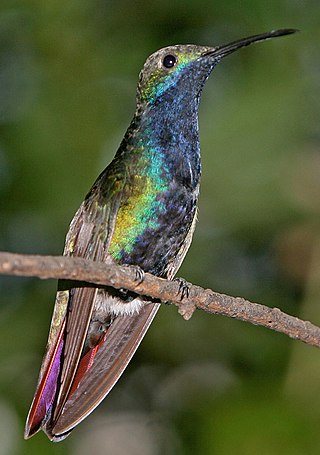
The black-throated mango is a species in subfamily Polytminae of the hummingbird family Trochilidae. It is found in Panama, in every mainland South American country except Chile, and on Trinidad and Tobago.

The green-breasted mango or Prevost's mango is a species in subfamily Polytminae of the hummingbird family Trochilidae. It is found from eastern Mexico south through most of Central America, in Colombia and Venezuela, and as a vagrant in the United States.

The purple-throated mountaingem is a species of hummingbird in tribe Lampornithini of subfamily Trochilinae. It is found in Costa Rica, Nicaragua, and Panama.
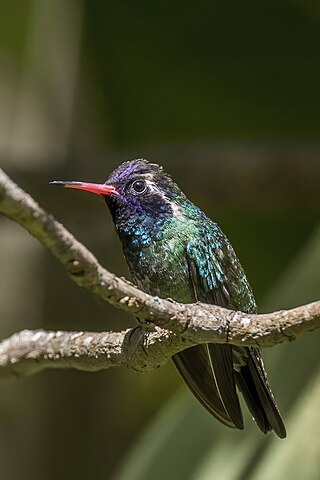
The white-eared hummingbird is a species of hummingbird in the "emeralds", tribe Trochilini of subfamily Trochilinae. It is found from the southwestern U.S. to Nicaragua.
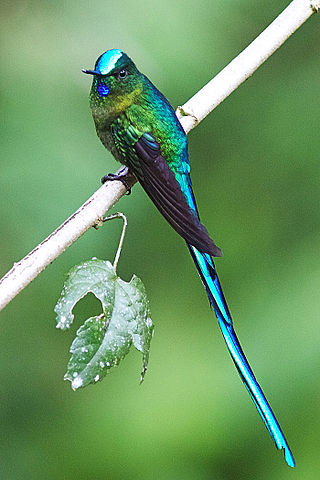
The long-tailed sylph is a species of hummingbird in the "coquettes", tribe Lesbiini of subfamily Lesbiinae. It is found in Bolivia, Colombia, Ecuador, Peru, and Venezuela.

The wine-throated hummingbird is a species of hummingbird in tribe Mellisugini of subfamily Trochilinae, the "bee hummingbirds". It is found in El Salvador, Guatemala, Honduras, and Mexico.

The bumblebee hummingbird is a species of hummingbird in tribe Mellisugini of subfamily Trochilinae, the "bee hummingbirds". It is endemic to Mexico, but has occurred as a vagrant in the United States.

The olivaceous thornbill is a species of hummingbird in the "coquettes", tribe Lesbiini of subfamily Lesbiinae. It is found in Bolivia and Peru.

The blue-mantled thornbill is a species of hummingbird in the "coquettes", tribe Lesbiini of subfamily Lesbiinae. It is found in Bolivia, Ecuador, and Peru.

The buff-winged starfrontlet is a species of hummingbird in the "brilliants", tribe Heliantheini in subfamily Lesbiinae. It is found in Colombia, Ecuador, and Peru.

The violet-fronted brilliant is a species of hummingbird in the "brilliants", tribe Heliantheini in subfamily Lesbiinae. It is found Bolivia, Colombia, Ecuador, Peru, and Venezuela.

The amethyst-throated mountaingem, also called amethyst-throated mountain-gem or amethyst-throated hummingbird, is a species of hummingbird in tribe Lampornithini of subfamily Trochilinae. It is found in El Salvador, Guatemala, Honduras, and Mexico.

The shining-green hummingbird is a species of hummingbird in the "emeralds", tribe Trochilini of subfamily Trochilinae. It is found in Colombia and Venezuela.
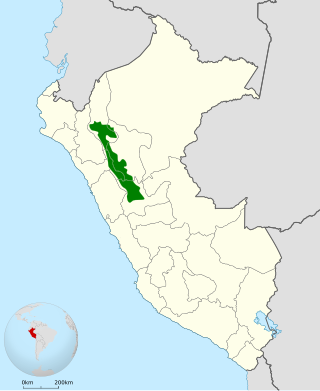
The coppery metaltail is a species of hummingbird in the "coquettes", tribe Lesbiini of subfamily Lesbiinae. It is endemic to Peru.

The black-backed thornbill is an Endangered species of hummingbird in the "coquettes", tribe Lesbiini of subfamily Lesbiinae. It is endemic to the Sierra Nevada de Santa Marta of northern Colombia.

The fork-tailed woodnymph is a species of hummingbird in the "emeralds", tribe Trochilini of subfamily Trochilinae. It is found in every mainland South American country except Chile and Uruguay.

Longuemare's sunangel is a species of hummingbird in the "coquettes", tribe Lesbiini of subfamily Lesbiinae. It is found in Colombia and Venezuela.

The crowned woodnymph or violet-crowned woodnymph is a species of hummingbird in the "emeralds", tribe Trochilini of subfamily Trochilinae. It is found from Belize and Guatemala to northern Peru.
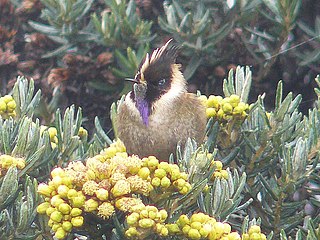
The buffy helmetcrest is a Vulnerable species of hummingbird in the "coquettes", tribe Lesbiini of subfamily Lesbiinae. It is endemic to Colombia.

The Talamanca hummingbird or admirable hummingbird is a species of hummingbird in the "mountain gems", tribe Lampornithini in subfamily Trochilinae. It is found in Costa Rica and Panama.























